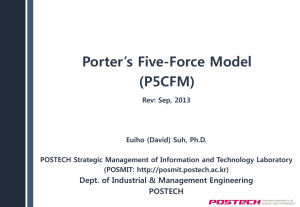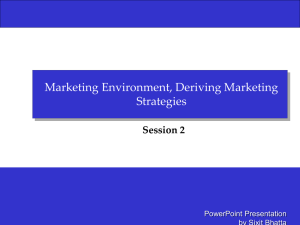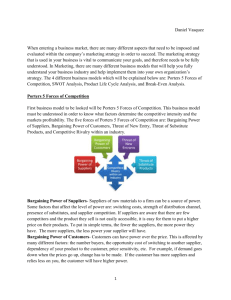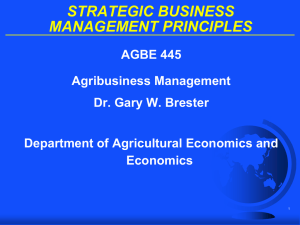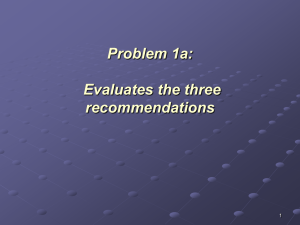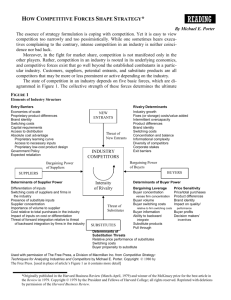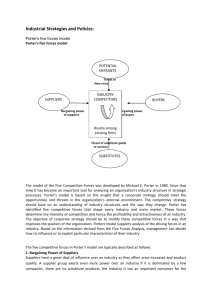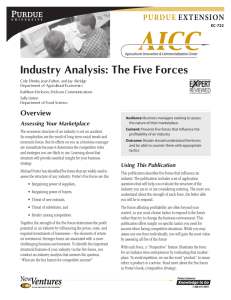Five Forces Industry Analysis
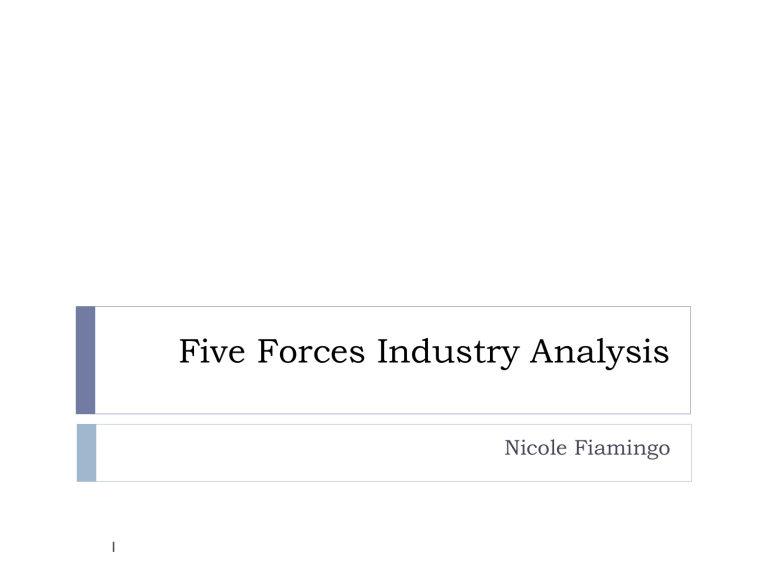
1
Five Forces Industry Analysis
Nicole Fiamingo
Five Forces Industry Analysis
Description & Purpose
Developed by Michael Porter
Provides an understanding of an industry and its participants
Used as a means to decrease the gap between a firm’s external environment and its internal resources
2
Five Forces Industry Analysis
Objective of the Five Forces
Identify the profit potential of an industry
Identify the forces that would harm your company’s profitability in that industry
Protect and extend your competitive advantage
Anticipate changes in industry structure
3
Five Forces Industry Analysis
Porter’s Five Forces
3.
4.
1.
2.
5.
Threat of new entrants
Bargaining power of suppliers
Bargaining power of buyers
Threat of substitute products or services
Degree of rivalry among existing competitors
4
5
Five Forces Industry Analysis
1. Threat of New Entrants
1.
2.
3.
4.
5.
6.
7.
8.
9.
New entrants usually face several barriers to entry, including:
Entry-deterring price
Incumbent retaliation
High entry costs
Experience effects
Other cost advantages
Product differentiation
Distribution access
Government restrictions
Switching costs
6
Easy to Enter if there is:
• Common technology
• Little brand franchise
• Access to distribution channels
• Low scale threshold
Difficult to Enter if there is:
• Patented or proprietary know-how
• Difficulty in brand switching
• Restricted distribution channels
• High scale threshold
Easy to Exit if there are:
• Salable assets
• Low exit costs
• Independent businesses
7
Difficult to Exit if there are:
• Specialized assets
• High exit costs
• Interrelated businesses
Five Forces Industry Analysis
2. Bargaining Power of Suppliers
Suppliers bargaining power may be influenced by:
3.
4.
1.
2.
5.
Concentration
Diversification
Switching costs
Organization
Government
8
Suppliers are Powerful if:
Credible forward integration threat by suppliers
Suppliers concentrated
Significant cost to switch suppliers
Customers Powerful
Suppliers are Weak if:
Purchase commodity products
Concentrated purchasers
Customers Weak
Example
Baxter International, manufacturer of hospital supplies, acquired American
Hospital Supply, a distributor
Drug industry's relationship to hospitals
Microsoft's relationship with PC manufacturers
Boycott of grocery stores selling nonunion picked grapes
Example
Grocery store brand label products
Garment industry relationship to major department stores
Travel agents' relationship to airlines http://www.quickmba.com/strategy/porter.shtml
9
Five Forces Industry Analysis
3. Bargaining Power of Buyers
Buyer’s Bargaining power my be influenced by:
3.
4.
1.
2.
Differentiation
Concentration
Profitability
Quality
10
Buyers are Powerful if: Example
Buyers are concentrated - there are a few buyers with significant market share
Buyers purchase a significant proportion of output - distribution of purchases or if the product is standardized
Buyers possess a credible backward integration threat - can threaten to buy producing firm or rival
Buyers are Weak if:
Producers threaten forward integration producer can take over own distribution/retailing
Buyers are fragmented (many, different) no buyer has any particular influence on product or price
Producers supply critical portions of buyers' input - distribution of purchases
DOD purchases from defense contractors
Best Buy and Sears' large retail market provides power over appliance manufacturers
Large auto manufacturers' purchases of tires
Example
Movie-producing companies have integrated forward to acquire theaters
Most consumer products
Intel's relationship with PC manufacturers http://www.quickmba.com/strategy/porter.shtml
11
Five Forces Industry Analysis
4. Threat of Substitute Products or Services
Market displacement by existing/potential substitutes can be influenced by:
1.
2.
3.
Relative price/performance trade off
Switching costs
Profitability
12
The Threat of Substitutes is High Risk: The Threat of Substitutes Low Risk:
Consumer switching costs are low
Substitute product is cheaper than industry product
Consumer switching costs are high
Substitute product is more expensive than industry product
Substitute product quality is equal or superior to industry product quality
Substitute product quality is inferior to industry product quality
Substitute performance is equal or superior to industry product performance
Substitute performance is inferior to industry product performance
No substitute product is available http://www.wikicfo.com/Wiki/default.aspx?Page=Threat+of+Substitutes+-
+one+of+Porters+Five+Forces&AspxAutoDetectCookieSupport=1
13
Five Forces Industry Analysis
5. The Degree of Rivalry Among Existing Players
The intensity of competition within an industry is determined by:
3.
4.
5.
1.
2.
Market Growth
Cost Structure
Barriers to exit
Product switching
Diversity
14
Rivalry will be high:
There are a large number of similar sized firms (rather than a few dominant firms) all competing with each other for customers
The costs of leaving the industry are high e.g. because of high levels of investment. This means that existing firms will fight hard to survive because they cannot easily transfer their resources elsewhere
The level of capacity utilization. If there are high levels of capacity being under-utilized the existing firms will be very competitive to try and win sales to boost their own demand
The market is shrinking so firms are fighting for their share of falling sales
There is little brand loyalty so customer are likely to switch easily between products http://www.oup.com/uk/orc/bin/9780199296378/01student/additional/page_11.htm
15
Five Forces Industry Analysis
Strengths
Forecast future changes in each of the five forces
Discover how these changes will affect the other forces
Discover how the interrelated changes will affect the future profitability of the industry
Discover how you might change the strategy to exploit the changing industry structure
16
Five Forces Industry Analysis
Weaknesses
Underestimates the capabilities that may serve as the company’s competitive advantage in the long-term
Does not take into account the synergies and interdependence within a corporation’s overall portfolio
Strict interpretations ignore social & political factors
Does not address why or how companies are able to get advantageous positions
17
Five Forces Industry Analysis
How to Do It
Step 1: Collect Information
Identify your industry
Look at existing demand & supply patterns
Identify the characteristics of each of the five forces
Examine & assess their impact on the industry
18
Five Forces Industry Analysis
How to Do It
Main Sources of Competitive Pressures
1.
Rivalry among competitors
2.
3.
Threat of substitute products
Threat of potential entry
4.
5.
Bargaining power of suppliers
Bargaining power of buyers
19
Five Forces Industry Analysis
How to Do It
Step 2: Assess & Evaluate
Determine the direction of the force
Give each force a value indicating if it is strong, moderate, or weak.
Scale of 1 – 5, with 1 being the weakest
The ultimate goal:
To identify the ability of your company to successfully compete within its industry, of the five forces given the collective strength
20
Five Forces Industry Analysis
How to Do It
Step 3: Develop Strategy
Repeat the first two steps in light of industry change and evolution
Long-term industry trends should be analyzed to determine whether the profitability of the industry is sustainable and how this will affect your company’s competitive position.
21
Five Forces Industry Analysis
Conclusion
Understanding how an industry will evolve provides important direction for selecting and managing strategy around these five criteria
Not all industries are alike-for companies with product portfolios across numerous industries, this technique should be repeated for each industry
22
